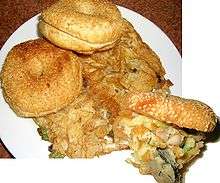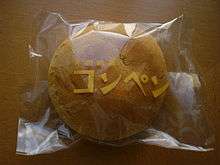Kompyang
|
A kompia from Jian'ou in China's Fujian Province | |
| Alternative names | Kompyang |
|---|---|
| Type | Bread |
| Place of origin | China, Malaysia, Taiwan, Japan |
| Region or state | Fujian, Sarawak, Perak, Matsu, Ryukyus |
| Main ingredients | Lard, onions, flour, salt |
|
| |
| Kompyang | |||||||||||||||||||||||||||
| Chinese name | |||||||||||||||||||||||||||
|---|---|---|---|---|---|---|---|---|---|---|---|---|---|---|---|---|---|---|---|---|---|---|---|---|---|---|---|
| Traditional Chinese | 光餅 | ||||||||||||||||||||||||||
| Simplified Chinese | 光饼 | ||||||||||||||||||||||||||
| |||||||||||||||||||||||||||
| Indonesian name | |||||||||||||||||||||||||||
| Indonesian | kompia | ||||||||||||||||||||||||||
| Okinawan name | |||||||||||||||||||||||||||
| Okinawan | 光餅 / コンペン | ||||||||||||||||||||||||||
Kompia[1] or kompyang (Chinese: 光餅; Minbei: guáng-biǎng; Mindong: guŏng-biāng; Hinghwa:gng-biâⁿ; Minnan: kiâm-kong-piáⁿ [鹹光餅]; Okinawan: 光餅 / コンペン konben; Malay: kompia or roti kompyang; Indonesian: kompia), is a bread product originates from Fuzhou, the capital city of Fujian Province of China.[2] It is popular in Fujian and has spread to other areas including the Ryukyus, Taiwan, and parts of Southeast Asia including the Malaysian towns of Sitiawan, Sibu,[1] Ayer Tawar, Sarikei,[3] Bintangor and other places where the dominant Chinese community is of Foochow (Hokchiu) ancestry (where it is sometimes nicknamed "Foochow bagels").
History
Kompia was named after Qi Jiguang, who invented it. When Qi Jiguang led his troops into Fujian in 1563, the Japanese pirates, fearing his name, engaged mainly in guerrilla-style battles. Qi Jiguang noticed that the Japanese pirates could always trace where his troops camped because of the smoke that rose up to the sky when the soldiers prepared their meals. He found out the Japanese pirates had no such problem because they brought onigiri with them. So Qi Jiguang invented a kind of bread with a hole in the center so that they could be strung together to be conveniently carried along. Later, to commemorate Qi Jiguang's victory against the pirate raiders, the bread was named guáng-biǎng (lit. "Jiguang cake").
Ingredients
Kompia is made with lard, onions, salt and flour. A ball of flour is stuffed with a filling of other desired ingredients and flattened with a rolling pin. It is then slapped onto the sides of a traditional home-made Chinese oven and takes approximately 15 minutes to bake. Meat is often used as a filling in the bread.


References
- 1 2 Simon Richmond, et al. Lonely Planet: Discover Malaysia & Singapore. Lonely Planet, 2013. ISBN 9781743216590
- ↑ "Fuzhou Snacks: Kompia". Lifeislikethat.com. Retrieved 2013-10-14.
- ↑ "Sarikei Time Capsule®: Food - Sarikei Kom Pia". Sarikei-time-capsule.blogspot.com. 2007-06-30. Retrieved 2013-10-14.